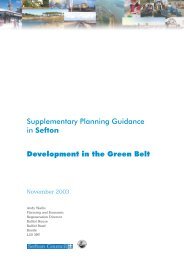The impact of sand extraction at Formby Point ... - Sefton Council
The impact of sand extraction at Formby Point ... - Sefton Council
The impact of sand extraction at Formby Point ... - Sefton Council
You also want an ePaper? Increase the reach of your titles
YUMPU automatically turns print PDFs into web optimized ePapers that Google loves.
9<br />
<strong>The</strong> veget<strong>at</strong>ion <strong>of</strong> the main quarry area was mapped and its (pre-NVC) communities<br />
described by Smith (1980). Twenty-seven years on, the area is essentially similar; a<br />
slightly undul<strong>at</strong>ing topography supports a mosaic <strong>of</strong> grassy fixed-dune on the higher<br />
ground and extensive areas <strong>of</strong> fixed-dune with Creeping Willow in the lower-lying areas.<br />
<strong>The</strong> l<strong>at</strong>ter community corresponds with the NVC’s SD16 (Salix repens – Holcus lan<strong>at</strong>us<br />
dune-slack) (dryer type) while the former is mapped as SD7 (Ammophila arenaria –<br />
Festuca rubra semi-fixed dune) by G<strong>at</strong>eley & Michell (2004). To the east, the Creeping<br />
Willow is frequently accompanied by Tuberous Pea (L<strong>at</strong>hyrus tuberosus), an <strong>at</strong>tractive<br />
alien which has been known here since the 1920s (Smith 1980). <strong>The</strong> n<strong>at</strong>ionally rare<br />
Dune Helleborine (Epipactis dunensis) occurs sparingly amongst the Creeping Willow<br />
but none was seen during this study.<br />
Especially to the north and east are sc<strong>at</strong>tered clumps <strong>of</strong> scrub, comprising mainly White<br />
Poplar (Populus alba), Sea Buckthorn (Hippophae rhamnoides), Grey Willow, Fine<br />
Osier, Balm <strong>of</strong> Gilead, birch and Hawthorn (Cr<strong>at</strong>aegus monogyna). <strong>The</strong> White Poplar<br />
and Sea Buckthorn clumps are suckering freely into adjacent habit<strong>at</strong>s. Several specimens<br />
<strong>of</strong> Salix x friesiana were recorded. Interestingly, <strong>at</strong> various points along the western and<br />
southern quarry boundaries there are large willow p<strong>at</strong>ches, domin<strong>at</strong>ed by Fine Osier and<br />
Grey Willow, but also including Osier (S. viminalis), Go<strong>at</strong> Willow (S. caprea) and S. x<br />
friesiana. <strong>The</strong>ir establishment may have been encouraged by percol<strong>at</strong>ion <strong>of</strong> w<strong>at</strong>er from<br />
the adjacent high dunes.<br />
Three wet-slacks were mapped by Smith (1978a); these together with three damp slacks<br />
were sampled by Smith (1980) using NVC methodology. <strong>The</strong>y flooded in 1977 and,<br />
especially deeply, in 1982 when N<strong>at</strong>terjack Toads bred successfully. In 1980, all these<br />
slacks had a diverse veget<strong>at</strong>ion, though most were domin<strong>at</strong>ed by Creeping Willow. This<br />
is still the case, although the slacks now appear to be dryer, as would be expected after 27<br />
years <strong>of</strong> sediment accumul<strong>at</strong>ion. <strong>The</strong> largest and richest was slack 1, described by Smith<br />
(1980) as having Creeping Willow around the edge, which soon gives way to a heavily<br />
Rabbit-grazed sward domin<strong>at</strong>ed by bryophytes together with a high diversity <strong>of</strong> lowgrowing<br />
vascular plants. As in 1980, a well-used informal footp<strong>at</strong>h runs the length <strong>of</strong> the















